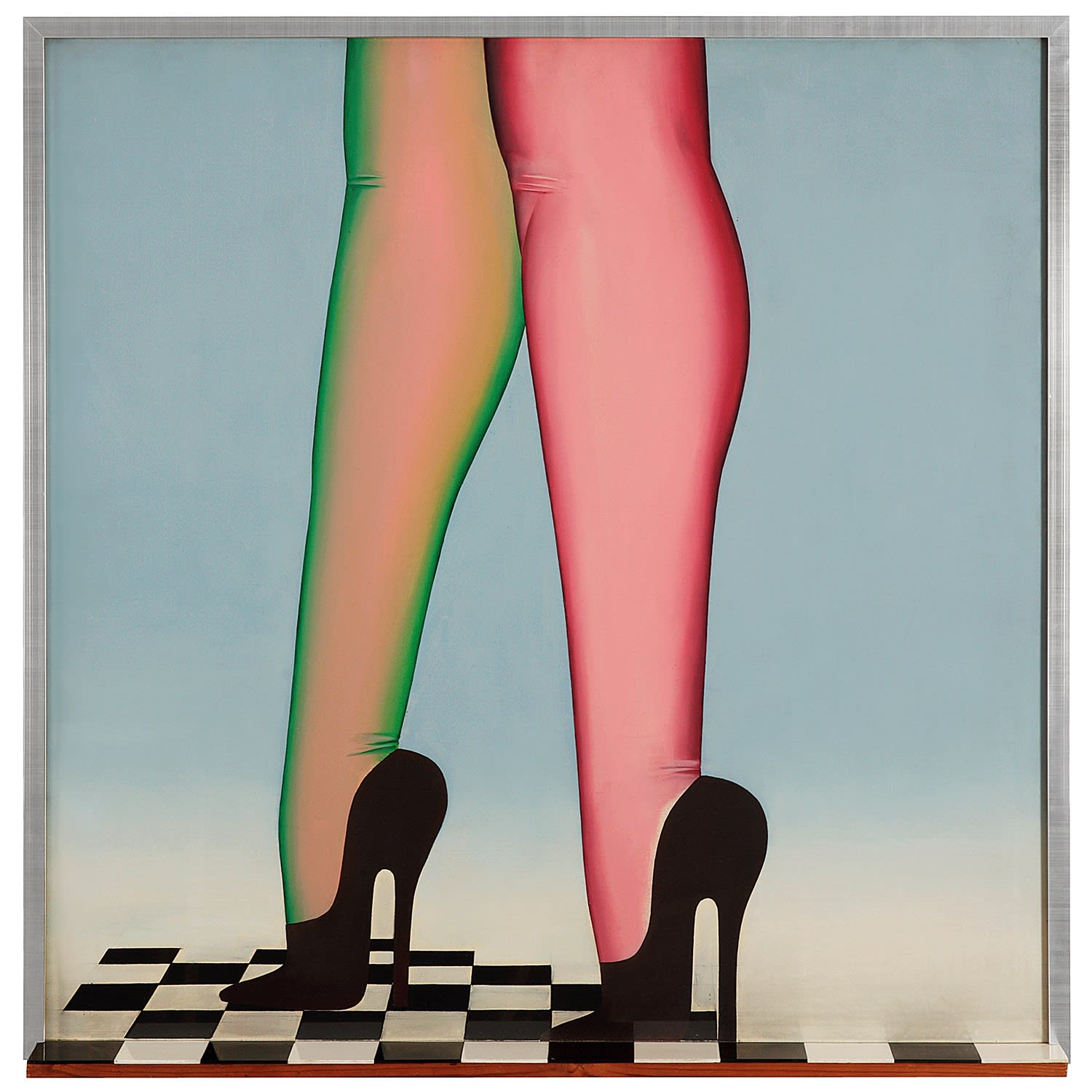Allen Jones b. 1937
One step back, 1966
oil on canvas and plastic tiles mounted on panel
37 3/8 x 37 1/8 inches
95 x 94 cm
95 x 94 cm
signed, titled and dated on the overlap
The 1960s were pivotal for Allen Jones. Despite being expelled from the Royal College of Art in 1960 after just one year, in 1961 he featured alongside David Hockney, R....
The 1960s were pivotal for Allen Jones. Despite being expelled from the Royal College of Art in 1960 after just one year, in 1961 he featured alongside David Hockney, R. B. Kitaj, Derek Boshier, Peter Phillips and Patrick Caulfield in the seminal ‘Young Contemporaries’ exhibition, which was seen as a manifestation of British Pop art. Two years later he received the ‘Prix des Jeunes Artistes’ at the Paris Biennale, cementing his international reputation and in 1964 he travelled to New York, to experience first-hand America’s burgeoning Pop movement.
On his travels throughout the USA in 1965, Jones discovered the work of American fetish illustrators Eric Stanton (1926 – 1999) and Eugene Bilbrew (1923 – 1974), and the mail order catalogue Frederick’s of Hollywood, teeming with highly stylised illustrations of women, lingerie and stilettos. For Jones, Pop offered new possibilities of representing the figure and he consciously appropriated the slick, sexualised visual language of commercial advertising. Back in London, he produced a series of paintings of legs and feet in stilettos, on three-foot-square canvases, to which he attached a wooden shelf (or shelves), covered with melamine tiles. The artist derived the titles of these paintings, including One Step Back, from the names of shoes that appeared in Frederick’s.
In his ‘leg paintings’ Jones depicts the legs roughly lifesize, which, as Marco Livingstone has noted, ’establishes a physical relationship with the viewer’ and ’provides the sensation of human presence’.¹ While the shiny black stiletto can be understood as shorthand for domination and sadomasochistic sex, ’the leg (…) is a potent symbol for the erotically
desirable woman, and thus conveys a distinct emotional charge’.2 Here, the figure’s sexual appeal is emphasised by the slenderness of the legs; the curvature of the calves; exaggerated height of the heels; exuberant colour of the tights; and the taut creases at the ankle and knee, which encourage a fetishistic reading of fabric clinging to skin.
For Jones, there was a fundamental distinction between the work being made by London Pop artists and their New York counterparts, ‘It seemed plain to me that it came down to the fact that the British artists refused to abandon illusionism.’ 3 Here, Jones’ inclusion of the shelf effectively breaks down the psychological barrier between the viewer and the image, by suggesting a continuity from imagined space to real space, while simultaneously underlining the flatness of the canvas. He experimented with this idea in other ways by using shaped canvases and fold-out panels and incorporating relief into his paintings. This idea culminated in number of paintings in which steps extended out and down to the gallery floor, implying that we might ourselves walk into the scene.
1 Marco Livingstone, Allen Jones: Sheer Magic, Congreve Publishing Company, New York, 1979, p78
2 Ibid
3 Jones cited in Martin Gayford, ‘Allen Jones on reinventing art’, RA Magazine, Winter 2014
On his travels throughout the USA in 1965, Jones discovered the work of American fetish illustrators Eric Stanton (1926 – 1999) and Eugene Bilbrew (1923 – 1974), and the mail order catalogue Frederick’s of Hollywood, teeming with highly stylised illustrations of women, lingerie and stilettos. For Jones, Pop offered new possibilities of representing the figure and he consciously appropriated the slick, sexualised visual language of commercial advertising. Back in London, he produced a series of paintings of legs and feet in stilettos, on three-foot-square canvases, to which he attached a wooden shelf (or shelves), covered with melamine tiles. The artist derived the titles of these paintings, including One Step Back, from the names of shoes that appeared in Frederick’s.
In his ‘leg paintings’ Jones depicts the legs roughly lifesize, which, as Marco Livingstone has noted, ’establishes a physical relationship with the viewer’ and ’provides the sensation of human presence’.¹ While the shiny black stiletto can be understood as shorthand for domination and sadomasochistic sex, ’the leg (…) is a potent symbol for the erotically
desirable woman, and thus conveys a distinct emotional charge’.2 Here, the figure’s sexual appeal is emphasised by the slenderness of the legs; the curvature of the calves; exaggerated height of the heels; exuberant colour of the tights; and the taut creases at the ankle and knee, which encourage a fetishistic reading of fabric clinging to skin.
For Jones, there was a fundamental distinction between the work being made by London Pop artists and their New York counterparts, ‘It seemed plain to me that it came down to the fact that the British artists refused to abandon illusionism.’ 3 Here, Jones’ inclusion of the shelf effectively breaks down the psychological barrier between the viewer and the image, by suggesting a continuity from imagined space to real space, while simultaneously underlining the flatness of the canvas. He experimented with this idea in other ways by using shaped canvases and fold-out panels and incorporating relief into his paintings. This idea culminated in number of paintings in which steps extended out and down to the gallery floor, implying that we might ourselves walk into the scene.
1 Marco Livingstone, Allen Jones: Sheer Magic, Congreve Publishing Company, New York, 1979, p78
2 Ibid
3 Jones cited in Martin Gayford, ‘Allen Jones on reinventing art’, RA Magazine, Winter 2014
Provenance
Arthur Tooth & Sons, London
Private Collection, France, acquired from the above in 1967
Private Collection, Italy
Exhibitions
Valdagno, Marzotto Institution, European Community Contemporary Painting Exhibition, Marzotto Prize,1966 – 1967: Metropolitan Scene: Images and Objects, September 1966 – August 1967, cat no.66, touring to:Baden Baden, Staatliche Kunsthalle
Copenhagen, Louisiana Museum
Amsterdam, Stedelijk Museum
London, Tate Gallery
Paris, Musée Galliéra



